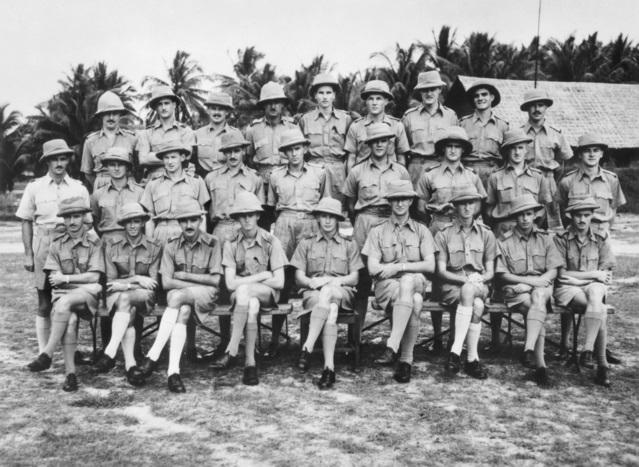Australia’s first action in the Pacific in World War II a valiant catastrophe
Posted By Patrick Walters on April 1, 2021 @ 12:40

Just before midnight on 7 December 1941, Flying Officer Peter Gibbes stepped off the train at Kota Bharu on the coast of northeast Malaya after a long, tiring journey up the peninsula from Singapore. Gibbes, an airline pilot in peacetime, had been newly posted to the Royal Australian Air Force’s 1 Squadron, which in the ensuing hours would become the first Australian military unit to see action in the Pacific War.
Soon after he headed for bed at the officer’s mess at Kota Bharu airfield, the sound of gunfire shattered the balmy night air. Reassured by the mess staff that the noise was simply an exercise, Gibbes tried to snatch some sleep. Then, as the firing intensified, he quickly dressed and headed straight for the squadron operations room. There he was greeted by a scene of utter confusion as the duty operations officer barked orders at stunned 1 Squadron pilots to get their Lockheed Hudson aircraft airborne, head out to sea and ‘drop some bombs’.
Not far off the coast, Japanese transport vessels had commenced disembarking 5,000 troops destined to land on the sandy beaches a short distance from Kota Bharu airfield. In Malaya, it was soon after 2 am on 8 December—an hour before the surprise Japanese air raid thousands of kilometres away on the other side of the Pacific Ocean at Pearl Harbor, Hawaii. The Pacific War had begun.
According to leading RAAF historian Alan Stephens, Gibbes grabbed a life jacket and parachute and, as he headed for the Hudson’s lined up along the airfield’s grass strip, inquired, ‘[W]hich way is it to the sea?’ The reply was to head for the ‘flashes and bangs’. Arriving at his allocated aircraft, he found his three aircrew. ‘None had ever met him and he was not wearing any rank or pilot’s wings that might have reassured them of his legitimacy,’ writes Stephens, ‘yet they were expected to put their lives in his hands, as they flew together for the first time, into combat. This was amateurism on a grand scale.’
Once airborne, Gibbes quickly located the incoming Japanese transports and, at mast height and heading into heavy enemy anti-aircraft fire, dropped four 250-pound bombs. Within minutes he was back at the Kota Bharu airfield to rearm for another sortie.

In early December 1941, intelligence reports began flowing into the Royal Air Force’s Far East Command in Singapore citing Japanese shipping and aircraft movements in the South China Sea heading west towards the Gulf of Siam. Four RAAF squadrons (Nos 1 and 8 squadrons equipped with Hudson light bombers and Nos 21 and 453 squadrons equipped with obsolete Brewster Buffalo fighters) had been deployed to Singapore’s Sembawang airfield from late 1940. In August 1941, anticipating a possible Japanese invasion of Malaya, 1 Squadron had relocated to Kota Bharu, close to the Thai border. In early December 8 Squadron also transferred up the peninsula to Kuantan with both squadrons assigned reconnaissance roles.
On Saturday 6 December, a three-aircraft patrol from 1 Squadron took off from Kota Bharu. Soon after midday, Flight Lieutenant Jack Ramshaw’s Hudson spotted Japanese naval vessels heading into the Gulf of Siam an estimated 400 kilometres northeast of Kota Bharu. A sizable enemy naval convoy had been identified, including one battleship, five cruisers, seven destroyers and 22 transports.
The following day brought heavy rain and dense low-level cloud, making aerial reconnaissance difficult for 1 Squadron’s patrols. But by late afternoon Japanese naval vessels had been detected just 170 kilometres north of Kota Bharu. In fact, three large Japanese transports, protected by two battle cruisers and a destroyer screen, were steaming towards Kota Bharu, with 1 Squadron’s aerodrome a key objective for the initial Japanese assault on Malaya.
Faced with mounting evidence of an imminent seaborne invasion, the British high command in Singapore vacillated. The commander-in-chief, Air Chief Marshal Robert Brooke-Popham, declined to implement Matador, the defence plan for Malaya, and initiate any pre-emptive strike against the incoming Japanese invasion force. Notwithstanding the intelligence gleaned from allied aerial reconnaissance, the Singapore command believed the Japanese were headed for Thailand.
Within hours, hostilities were underway and 1 Squadron launched repeated attacks on the enemy’s landing craft and transports headed for Kota Bharu, scoring a direct hit on the 9,800-tonne transport Awagisan Maru—the first Japanese merchant ship to be sunk in the Pacific War. One of the RAAF bombers, A16-94, piloted by Flight Lieutenant John Jones, which had taken off at 2.20 am, was lost only minutes afterwards. Jones and his crew—First Officer Ron Siggins and Sergeants Graham Hedges and David Walters—were the first Australians to die in the war.
By midday on 8 December, Japanese forces had successfully established a bridgehead on the Malay peninsula and Kota Bharu airfield itself came under repeated attack from Japanese navy Zero fighters flying from nearby Thailand. In the afternoon, the situation became perilous, with pockets of Japanese troops penetrating close to the airfield perimeter. Just before dusk, having received orders from Singapore that the airfield should be abandoned, 1 Squadron’s five remaining serviceable aircraft took off for Kuantan, heavily laden with men and vital supplies. A total of eight aircraft had been lost in the short-lived battle to defend Kota Bharu.
As the victorious Japanese swept down the Malay peninsula, the two badly depleted RAAF squadrons soon found themselves back in Singapore before evacuating to Palembang in Sumatra and thence to Java, where many surviving members of 1 Squadron ended up as Japanese prisoners of war. For the RAAF, the action at Kota Bharu had proved a bitter lesson, underscoring a manifest lack of effective combat airpower, and shattering long-held assumptions about the inferior military capability of their foe.
Article printed from The Strategist: https://aspistrategist.ru
URL to article: /australias-first-action-in-the-pacific-in-world-war-ii-a-valiant-catastrophe/
Click here to print.